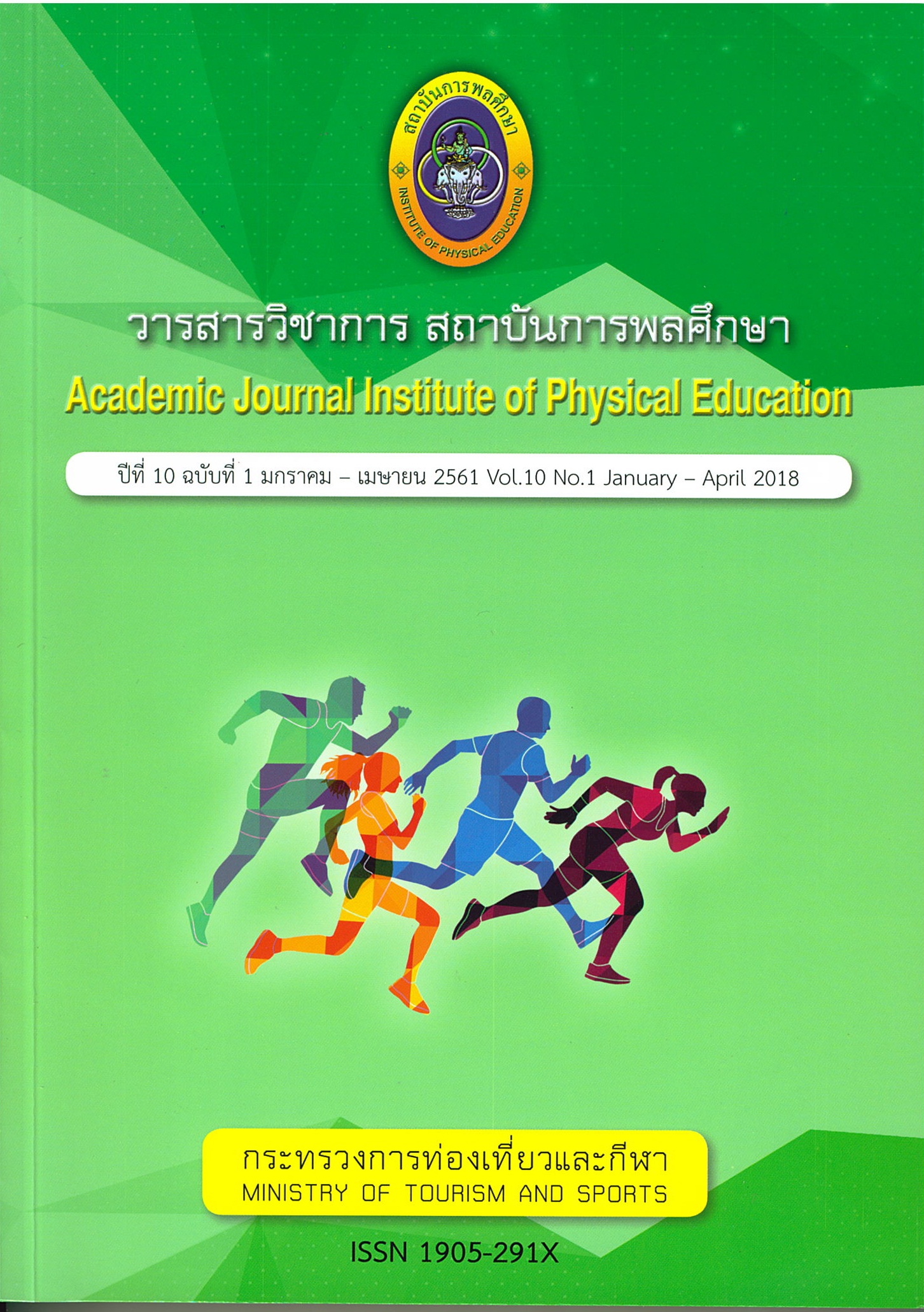Development of a Health Literacy Test for Primary School Students
Main Article Content
Abstract
The purpose of this research was to develop a Health Literacy test for primary school students. The procedures were to synthesize Health Literacy factors, to construct Health Literacy test for primary students and to check the quality of the Health Literacy test. The sample of the study consisted of 2,056 upper primary students and the try out group for developing test was 352 primary students. The sample was drawn by purposive multistage random sampling and the try out group was drawn by simple random sampling from the schools under the Office of the Basic Education commission. The reliability of the test was analyzed by using Cronbach’s alpha coefficient. The criterion related validities were confirmed by the correlations between the Health Literacy scores and Health assessment scores; physical, mental and social health. The statistics were descriptive, Cronbach’s alpha coefficient, and Pearson’s products moment correlation. The research findings were as follows:
1) The Health Literacy test consisted of 4 Dimensions include Access, Learning, Decision and Using. There were of 50 items, each question had 3 choices which score weight ranged from 1-3. 2) The reliability of the test by using Cronbach’s alpha coefficient value for tryout group and the sample group were .735 and .701 respectively. 3) The correlation between the Health Literacy scores and the scores from physical health and social health assessment of the try out group were .115 and .185 respectively. For the sample group in the data collection step, the correlation value between the Health Literacy scores and physical health and social health scores were .058 and .164 185 respectively.
Article Details
The published article is a copyright of the Academic Journal of Thailand National Sports University. The passage appeared in each article in this academic journal is a perspective of each author which is not related to the journal. Each author is required to be responsible for all components of his/her own article. If there are any mistakes, each author must be responsible for those mistakes on his/her own.
References
กรมอนามัย กระทรวงสาธารณสุข. (2542). เกณฑ์อ้างอิงน้ำหนัก ส่วนสูง และเครื่องชี้วัดโภชนาการของประชาชนไทยอายุ 1 วัน - 19 ปี.(ออนไลน์). แหล่งที่มา: http://www.rajini.ac.th/nurse/ test.pdf. 30 เมษายน 2558
กรมอนามัย กระทรวงสาธารณสุข. (2556). คู่มือการดำเนินงานโรงเรียนส่งเสริมสุขภาพ พ.ศ. 2556. กรุงเทพฯ: ศูนย์สื่อและสิ่งพิมพ์แก้วเจ้าจอม.
กองสุขศึกษา. (2554). ความฉลาดทางสุขภาพ. กรุงเทพฯ: กองสุขศึกษา กรมสนับสนุนบริการสุขภาพ กระทรวงสาธารณสุข
โชติกา ภาษีผล. (2554). การสร้างและพัฒนาเครื่องมือในการวัดและประเมินผลการศึกษา. พิมพ์ครั้งที่ 2. กรุงเทพฯ: คณะครุศาสตร์ จุฬาลงกรณ์มหาวิทยาลัย.
ฐิติยา แก้วสมบูรณ์. (2551). โปรแกรมจัดการเรียนรู้แบบมีส่วนร่วมเพื่อสร้างเสริมความแตกฉานด้านสุขภาพของผู้ป่วยมะเร็งปากมดลูกระยะก่อนลุกลาม. วิทยานิพนธ์ปริญญาวิทยาศาสตรมหาบัณฑิต. (สาธารณสุขศาสตร์). กรุงเทพฯ: บัณฑิตวิทยาลัย มหาวิทยาลัยมหิดล.
ณัฐภัทร์ เพ็ชรแก้ว. (2549). ดัชนีชี้วัดสุขภาพของนักเรียนระดับมัธยมศึกษาตอนปลาย. วิทยานิพนธ์ปริญญามหาบัณฑิต. (สุขศึกษา). กรุงเทพฯ: คณะครุศาสตร์ จุฬาลงกรณ์มหาวิทยาลัย.
นฤมล ตรีเพชรศรีอุไร และเดช เกตุฉ่ำ. (2554). รายงานการวิจัย เรื่อง การพัฒนาเครื่องมือวัดความฉลาดทางสุขภาพเกี่ยวกับโรคอ้วนของนักเรียนระดับมัธยมศึกษาปีที่ 3 (ระยะที่ 1). กรุงเทพฯ: สามเจริญพาณิชย์.
วราพรรณ วงษ์จันทร์. (2547). ดัชนีชี้วัดสุขภาพของนักเรียนมัธยมศึกษาตอนต้น.วิทยานิพนธ์ปริญญามหาบัณฑิต. (สุขศึกษา). กรุงเทพฯ: คณะครุศาสตร์ จุฬาลงกรณ์มหาวิทยาลัย.
ศิริชัย กาญจนวาสี. (2552). ทฤษฎีการทดสอบแบบดั้งเดิม. พิมพ์ครั้งที่ 6. กรุงเทพฯ: โรงพิมพ์แห่งจุฬาลงกรณ์มหาวิทยาลัย
สายัณห์ ละออเอี่ยม. (2541). การจัดและบริหารงานสุขภาพในโรงเรียน. ชลบุรี: มหาวิทยาลัยบูรพา.
สินศักด์ชนม์ อุ่นพรมมี และมนทน์ดวงพัฒน์ อุ่นพรมมี. (2551). รายงานวิจัยเรื่องความรู้และประสบการณ์เกี่ยวกับความแตกฉานด้านสุขภาพในนักศึกษาพยาบาลศาสตร์ ชั้นปีที่ 4 วิทยาลัยพยาบาลบรมราชชนนี นครราชสีมา. นครราชสีมา: วิทยาลัยพยาบาลบรมราชชนนีนครราชสีมา.
สุรภา ธีระวานิช. (2546). ดัชนีชี้วัดสุขภาพของนักเรียนในโรงเรียนชั้นประถมศึกษาปีที่ 4-6.วิทยานิพนธ์ปริญญามหาบัณฑิต. (สุขศึกษา). กรุงเทพฯ: คณะครุศาสตร์ จุฬาลงกรณ์มหาวิทยาลัย.
เอมอัชฌา วัฒนบุรานนท์. (2556). หลักการทางสุขศึกษา. กรุงเทพฯ: โอเดียนสโตร์.
Cormier, C. M. (2006). Health Literacy: The Knowledge and Experiences of Senior Level Baccalaureate Nursing Student. A Dissertation Submitted to the Graduate Faculty of the Louisiana State University and Agricultural and Mechanical College in partial fulfillment of the requirements for the degree of Doctor of Philosophy. Louisiana: Louisiana State University and Agricultural and Mechanical College.
National Assessment of Adult Literacy (NAAL). The National Assessment of Adult Literacy Test. [cited August 31 2011]. Available from: http:// www.naepdc.org/ about_NAEPDC/ NAAL.html
Norman, C.D., and Skinner, H.A. 2007. eHEALS: The Health Literacy Scale. Journal Medication International Research. 8(4): e27.
World Health Organization. (WHO) (2009). Health Literacy and Health Promotion. Definitions, Concepts and Examples in the Eastern Mediterranean Region. Individual Empowerment Conference Working Document. 7th Global Conference on Health Promotion Promoting Health and Development. Nairobi, Kenya.
Zarcadoolas, C., Pleasant, A.F., and Greer, D.S. (2006). Advancing Health Literacy: A Framework for Understanding and Action. San Francisco: Jossey – Bass Inc., Publishers.


